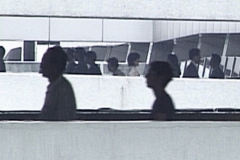ARTIST
EVA KOCH
MFA from The Royal Danish Academy and University of Barcelona, Department of Fine Arts.
Eva Koch works spatially in the fields of video installation, sound and sculpture. Her sculptures relate in scale to man’s own physical presence, most notably in her Earth Sculpture near the city of Esbjerg, created out of 800,000 cubic meters of earth, a clear landmark in the West Jutland landscape.
A recurrent theme in Eva Koch’s video works is the anonymous individual seen from a collective viewpoint. In her large-scale interactive video work VILLAR the viewer is given insight into a family whose lives have been affected by war. The work is a multi-faceted narrative showing us that truth has many aspects and that our memories are subjective.
Eva Koch’s art is often place-specific and interactive. Her works particularly revolve around the themes of communication and the shared features of human experience. Presented in a sensuous simple language in which image and word merge in extension of one another.
I would prefer not to
For the exhibition I would prefer not to Eva Koch shows her video Transit.
Eva Koch’s video Transit is about being on one’s way, in the “gap”, between here and there. Transit means the state of being moved. We are no longer active travellers, but transported, passive, each of us closed around our dream, stationary on the rolling walkways in unending movement from one transit hall to the next, from plane to plane, from one air-conditioned space to another. We are transported indoors, no longer having to move our bodies through the world and its unpredictable weather. Nevertheless we listen to the weather forecasts with undiminished interest; hour by hour we follow the updated reports about what it is like out there.
Meditations with artists Eva Koch & Andreas Albrectsen
In the first meditation over (art)work we have invited artists Eva Koch & Andreas Albrectsen to join us for a talk about the artworks exhibited at meter and their artistic practice. We invited the two of them to a joint conversation because we see similar inspirations driving their artistic practises but their treatment of the subject to be different both in method and in artistic output.

